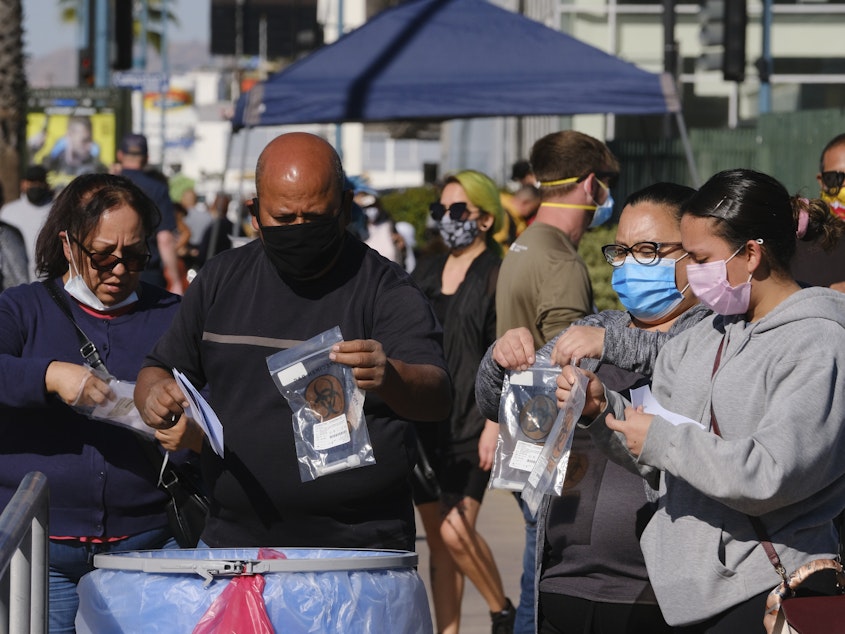California Residents Under Strict Stay-At-Home Orders Through Christmas

Nearly 85% of California residents are now under sweeping new restrictions as the state's struggles to bring the COVID-19 pandemic under control. The new restrictions come as coronavirus cases continue to surge and while the state's intensive care capacity has neared dangerously low levels.
Updated at 6:20 a.m.
Residents in Southern California and the San Joaquin Valley are under a stay-at-home order through the Christmas holiday as of 11:59 Sunday evening. The order means strict new closures for many businesses and a ban on gatherings with people outside your immediate household in two regions of the state that are collectively home to some 27 million people. The order will be in effect for at least three weeks.
The order was triggered after ICU capacity in the two regions fell below a 15% threshold announced this past week by Gov. Gavin Newsom. In Southern California, the rate fell to 12.5%, while in the San Joaquin Valley it had dipped to 8.6%, state health officials announced Saturday.
"Unlike previous surges, every hospital in California is under stress. There is no place to transfer people if we run out of beds," San Francisco Health Officer Dr. Tomás Aragón said. "Three-quarters of the state's hospital beds are currently full."
The trend is expected to continue throughout the rest of the state within the next week or two.
"We are at a tipping point in our fight against the virus, and we need to take decisive action now to prevent California's hospital system from being overwhelmed in the coming weeks," the governor said ahead of Saturday's announcement. By invoking the order, Newsom said, "we can flatten the curve as we've done before and reduce stress on our health care system."
The order marks a dramatic shift for California, which for months had managed to avoid the worst of the virus relative to the rest of the United States. Much of that success was owed to early action. In March, the state ordered all 39.5 million of its residents to stay at home indefinitely in what was then the widest-ranging directive in the nation. That order came at a time when California had roughly 1,000 confirmed cases and 19 deaths. As of Friday, the state had recorded more than 1.3 million cases and nearly 20,000 deaths.
Retailers, restaurants curtail operations
The latest directive will be felt in nearly every aspect of daily life. It asks residents to stay at home "as much as possible" and for "100 percent masking" when they are outside. Restaurants will be open only for takeout or pickup, while businesses such as hair and nail salons, movie theaters and bars will be closed. Playgrounds, museums and zoos will be closed as well.
Retailers, including grocery stores, will remain open, but capacity will be limited to 20%. Schools that are currently open will be allowed to continue in-person learning. Places of worship will also be allowed to stay open, but only for outdoor services.
Many small business owners, like hairstylist, Rosey Ibarra, are angry with the new restrictions.
Ibarra, a hair stylist in Temecula in Southern California, said she is not closing her business.
"I feel confident to properly and safely take care of my clients," she told CapRadio. "None of my clients have rescheduled, none of them feel that coming to my salon is going to be unsafe for them at this time."
The state has no easy way to enforce these new measures without the help of local police. But that's only an option if law enforcement is on board.
L.A. County Sheriff Alex Villanueva expressed his reluctance to shut down individual businesses. He said his focus will instead be on curbing "super spreader" events.
Newsom and health officials are counting on the power of persuasion to keep people home.
"Staying home for three weeks is a sacrifice, but if every Californian did that for a month, we could stop this disease in its tracks," said Dr. Erica Pan, the state's acting public health officer, when the restrictions were announced. "This public health order strikes the balance between saving lives, providing essential services that we all rely on and still allowing Californians to participate in lower-risk outdoor activities that are crucial for our physical and mental health."
'Whatever is necessary'
In the three other regions being tracked by the state — the Bay Area, Greater Sacramento and Northern California — ICU capacity was above 21%.
Some areas, however, weren't waiting for ICU capacity to fall below the state's threshold. Los Angeles County adopted a stay-at-home order late last month, and on Friday, health officials in five of the 11 counties that make up the Bay Area chose to follow suit. The five counties — Alameda, Contra Costa, Marin, Santa Clara and San Francisco — are home to some 5.8 million residents.
"We must do whatever is necessary in order to get the virus under control," said San Francisco Mayor London Breed on Friday. "This is about protecting people's lives. We see how quickly it moves and how devastating the effects. We need to do everything we can to prevent our hospital system from becoming overwhelmed and to save lives."
The rise in cases hitting California has mirrored the surge currently tearing through the rest of the country. On Saturday, the U.S. recorded 213,875 new cases and more than 2,200 deaths, according to the latest figures from Johns Hopkins University. More than 101,000 Americans were in the hospital, with roughly a fifth of those patients in the ICU.
CapRadio's Nicole Nixon contributed to this report. [Copyright 2020 NPR]
